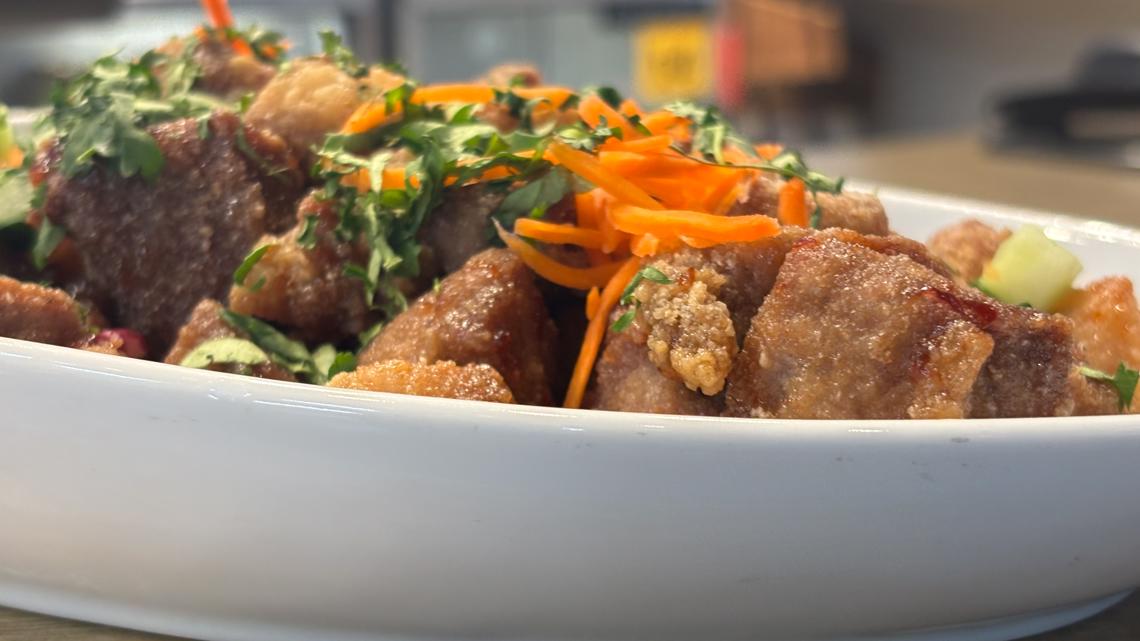Banana bread is simply an inevitability in life: You ignore that bunch of bananas, they become too brown to be appealing on their own, you make them into banana bread. For this reason I have never been especially picky about it. I tend to follow this loose banana bread ratio as opposed to a specific recipe, and, to be honest, don’t have especially high standards when it comes to the finished result. This, of course, makes it the perfect recipe to solidify for my roster through more structured testing.
For this month’s ranking, I chose four banana bread recipes from around the internet. The first, which I saw as a baseline, was an extremely standard, popular version. From here, I considered other highly ranked recipes that had major tweaks to their technique, such as the use of Greek yogurt, the absence of eggs or dairy, or the addition of unexpected enhancements like instant pudding mix.
Since I think most people approach banana bread through a lens of practicality, I wanted to see whether bulking up the ingredients list or the process would actually be worth it. And while inclusions like walnuts or chocolate certainly do improve a banana bread — I’ve loved this marbled version from Smitten Kitchen — I chose to test banana breads without inclusions in order to have a more even comparison. Here’s what I found.
:no_upscale()/cdn.vox-cdn.com/uploads/chorus_asset/file/25933495/IMG_9795.jpg)
Shelley Albeluhn, Allrecipes
The technique: Straightforward, like exactly what you expect
This recipe from the SEO juggernaut Allrecipes is the top-ranked banana bread recipe on the entire internet, with over 13,000 reviews to vouch for it. While I can’t recall ever making it before, it felt like every banana bread recipe I’ve ever made — the proto-banana bread, if you will. It is a mostly pantry-ingredients recipe; I used three ripe bananas for it, which seems typical for banana bread. There is also nothing remarkable about the recipe’s process: You mix the wet into the dry and then bake.
This recipe yields a tidy, modest loaf with a good rise, pleasant sweetness, and mild banana flavor. Its texture is uniform and the crumb is pretty tight. Though flecks of bananas are visible in the cross-section, I didn’t find them super noticeable when I was eating. In all, this was a no-nonsense, standard banana bread, though it was on the dry side compared to the others I tested. Of the four I baked, this one made me crave a topping — like a dollop of creme fraiche or even a drizzle of syrup — the most.
:no_upscale()/cdn.vox-cdn.com/uploads/chorus_asset/file/25933489/IMG_9798.jpg)
Katie Morford, Simply Recipes
The technique: The whole banana, peels and all; plus Greek yogurt
I like the idea of a “waste-free” recipe like this one, which uses unpeeled whole bananas. But as I sourced its ingredients, I found myself wondering how sustainable it really was — how much can the use of peels really offset the inclusion of eggs, maple syrup, Greek yogurt, a generous amount of olive oil, and whole-wheat pastry flour in addition to all-purpose? To me, “waste-free” makes the most sense when a recipe is also frugally minded; here, it felt a little like lip service. All of which is to say that I was skeptical.
Unlike the other recipes I tested, this one requires planning. You have to cut the ends off the bananas, freeze the bananas overnight, and thaw them to a texture the recipe describes as “melted,” though it’s really more “slimy.” You then puree the whole bananas in a food processor before mixing them into the wet ingredients. When it comes to banana bread, getting an appliance out is a demerit for me. For the sake of standardized tasting, I skipped the walnuts here.
The resulting bread was the darkest of the four, with a firm yet pliant texture and a deep, toasty sweetness. The loaf was also the most bready; it held together nicely and felt sturdy but not dry, likely due to the addition of Greek yogurt. Its flavor was nuanced, with an understated level of banana, and had a slightly wholesome vibe; the whole wheat comes through, as does the maple syrup and olive oil. Overall, it tastes like banana bread grew up and got a little snooty. Despite my initial hesitation, I really liked this recipe. I would definitely make it again, though not because of its eco-friendly, waste-saving halo; it just tastes quite good.
:no_upscale()/cdn.vox-cdn.com/uploads/chorus_asset/file/25933497/IMG_9797.jpg)
Bread Dad
The technique: Applesauce as an egg replacement and oil instead of butter
Given the current state of eggs, I am more cautious about how I’m using them. When an egg’s only job in a recipe is to offer binding, I’m more drawn to alternatives. So I was curious about this recipe, which is written to be egg-free and also offers an option for making it dairy-free (this makes it vegan and more budget-friendly too). Instead of eggs, it calls for applesauce, and while the instructions are written for butter, they note that neutral oil can be used, which I did. I know that some bakers prefer oil over butter for cakes because it can result in a more tender texture and doesn’t dry out as quickly.
The finished product was the moistest of the bunch, with a slightly squishy texture that was bordered by a slight but soft crust and dappled throughout with distinct chunks of mushy (in a good way!) banana. Because of this, I imagine that it’ll keep the best of the four, even if left exposed to air. It also had the most prominent banana flavor of all the loaves. The lack of eggs and butter wasn’t noticeable at all, making this a great all-purpose, accessible option.
:no_upscale()/cdn.vox-cdn.com/uploads/chorus_asset/file/25933499/IMG_9796.jpg)
Averie Sunshine, Averie Cooks
The technique: Lots of bananas; plus Greek yogurt and vanilla pudding mix
I’ve heard pastry chefs sing the praises of instant pudding mix for baking — according to Zoë Kanan, it can enhance flavor and lock in moisture, extending the shelf life of a bake — but I’d never tried it myself. Accordingly, I was eager to try this recipe, which is fortified with vanilla pudding mix and bills itself as a good way to get rid of a lot of bananas at once. It is, as a whole, a somewhat bloated recipe, as it also calls for two kinds of sugar and Greek yogurt. It even specifies that you may want a muffin pan or mini loaf pan for excess batter.
I’ll admit that I was stubborn: I didn’t pour the excess into another pan, mostly because I didn’t have one. Instead, I heaped the batter into a single loaf pan, which I set on a baking sheet. This recipe rises and the batter did overflow, though I suppose the higher yield is nice in theory. Unlike the other recipes, this one resulted in a caramelized, crackly top that gave way to a tender, even interior. I liked the variation in texture and flavor that this created. The finished bread had a pronounced sweetness that called out for a side of black coffee and a present but not overwhelming banana flavor. It is a very good banana bread, though it didn’t convince me to keep a package of pudding mix lying around. The overflow batter was a happy accident: It turned crackly and crunchy, almost like granola.
The winner: Bread Dad
I liked all of these recipes, which is something I can’t say of every recipe ranking I’ve done. Thus, my favorite came down to a question of ideology. When I think about banana bread and why we make it, I think about thrift and efficiency. So often banana bread is a way of repurposing bananas that are past their prime — bananas being, of course, one of the cheapest foods you can buy. So while I enjoyed the Averie Cooks and Simply Recipes versions, I also found their ingredients lists — and in the case of Simply Recipes, more complicated technique — to work somewhat against this spirit. To me, banana bread is food for when you’re strapped on cash, time, or ingredients but still want a little sweet treat, so for its ratio of simplicity to deliciousness to accessibility, the Bread Dad version wins out.
Banana bread photos: Bettina Makalintal















:max_bytes(150000):strip_icc():focal(1033x539:1035x541)/sydney-sweeney-jonathan-davino-9977c2bf55ac436a91909930d062b6ae.jpg)
